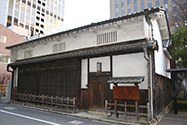Outline
Establishment of Osaka University Tekijuku Commemoration Center
The Osaka University Tekijuku Commemoration Center was established when Osaka University celebrated the 80th anniversary of its founding, as a new department of the University on April 1, 2011.

Tekijuku (or Tekitekisai juku), which still exists in Kitahama, Chuo-ku, Osaka City, was originally a traditional townhouse built in the late Edo period (1603-1868), presumably after the fire around Kitahama in 1792. OGATA Koan, the founder of Tekijuku, obtained the townhouse in 1845 and moved his clinic and school there (these were initially established in a nearby town in 1838. The Tekijuku building is valuable as Japan’s only architectural example of a pre-Meiji era school for Western learning still in existence. It was designated as a National Historical Landmark in 1941, and as a National Important Cultural Asset in 1964.
In 1869, temporary hospital (kari byōin) was established in Osaka with OGATA Koreyoshi (1843-1909), Koan’s son, as the president. Koreyoshi also worked together with Anthonius Franciscus Bauduin (1820-1885) and other Tekijuku graduates to play a central role in establishing modern medical system in Osaka. They also established Osaka Medical School (Osaka Igakkou) in 1870, inviting the Dutch doctor Christiaan Jacob Ermerins (1841-1880) to join the faculty. The hospital and the medical school then underwent many transitions and eventually developed into the School of Medicine of Osaka Imperial University, and finally into today’s Osaka University.
In 1942, the year after its designation as a National Historical Landmark, the Tekijuku building was passed into the possession of the Japanese government (in essence, Osaka Imperial University). Then after five years of renovations starting from 1976, Tekijuku was opened for public exhibition. Thus far, Osaka University and the Tekijuku Commemoration Association (Tekijuku kinen kai, established in 1952) have received valuable Tekijuku-related materials from the Ogata family and many other donors, including descendants of Tekijuku students. Researchers inside and outside the University have worked to preserve and study these precious materials.

From 2008, Osaka University considered the direction to be taken to maintain and improve the management of Tekijuku. This included its related material preservation as well as studying and honoring the achievements of Koan and his studentsa role which had previously been undertaken by the Tekijuku Commemoration Association and the Tekijuku Management Committee, a body within the University. As a result, Osaka University decided to establish the Tekijuku Commemoration Center. To ensure further development of Tekijuku-related activities, the Division of Osaka Studies and the Division of Dutch Studies have been newly added to the Center organization, which also includes the Tekijuku Commemoration Association. The Tekijuku Commemoration Center is now located in Osaka University Hall, which was approved as a resistrated tangible cultural asset in 2004 and was originally the school building of the former Naniwa High School (Naniwa koutou gakkou) under the prior education system.
Tekijuku Commemoration Center's Mission and Research Divisions
The mission of the Tekijuku Commemoration Center is to continue to collect and preserve Tekijuku-related material as well as to promote the activities which study the achievements of OGATA Koan and his students. This work was previously conducted mainly by the Tekijuku Commemoration Associationand the University’s Tekijuku Management Committee. In order to achieve its mission, the Center has set up three divisions, the Division of Tekijuku Management, the Division of Osaka Studies, and the Division of Dutch Studies.
Tekijuku was founded and developed in the culturalcontext of early-modern Osaka, and produced prominent individuals who played active roles in the international arena. Tekijuku was a place to pursue Western learning, which was imported to Japan through the Netherlands. Now Osaka University has established a partnership with the University of Groningen in the Netherlands. On the basis of this affiliation, the Tekijuku Commemoration Center has invited visiting academic staff from the Netherlands, aiming to serve as one of Japan’s centers for Dutch research and education.
The Center’s academic staff members, who also belong to particular departments of the University, work with the Center’s dedicated academic staff. The Tekijuku Commemoration Association is managed by incorporating opinions from members of the Advisory Board outside the University.


